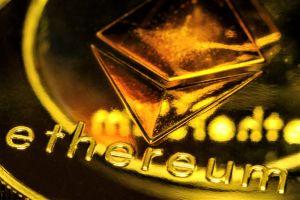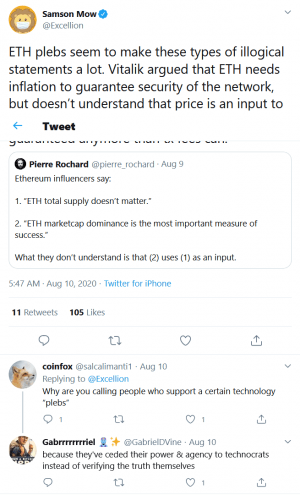Ethereum’s Supplygate Has Nuanced Answers & Hard Questions On Money
Following another heated Bitcoin (BTC) vs. Ethereum (ETH) debate, it looks like there is still no consensus on the exact supply of the world’s second-most valuable cryptoasset, ETH – or if it even matters. However, there is an approximation. (Updated at 12:51 UTC: updates in bold.)

Source: Adobe/Anton Gvozdikov
It’s a tale as old as ether-time: a story of a coin which the crypto-villagers have claimed for years has an infinite supply, wondering how and why. Others have been pointing out that there is a discrepancy in numbers on different block explorers.
Part of the Cryptoverse has been up in arms again, demanding for the Ethereum camp to reveal the exact number, as a part of what some have termed “the Supplygate” (a reference to the Watergate scandal in the US).
Much of the discussion lies in the argument that project leaders, developers, and the community must know the exact supply at all times for the coin to be sound money. Others disagree with this assumption.
MakerDAO developer Marc-André Dumas’ initial calculations led to a report of 112.43 million. Following a report of a bug in the script, he made a correction to ETH 112.093 million. “You can now be assured that there are are no nasty inflation bug in Ethereum. 112.1M is the number,” he stated yesterday.
However, just the amount of discussions led over the three days of his calculations, the corrections made, and the details that had to be taken into account would suggest that this was no easy task.
SetProtocol product marketing manager Anthony Sassano gave his two cents on this “noisy” discussion as well. “Even if you have a really great script, calculating the exact circulating ETH supply (and keeping it up to date) is tricky for a few reasons,” he wrote. It’s “rather difficult and there’s plenty of edge cases that need to be accounted for.” But Sassano noted that there are people who are calling for “making this a function call in Ethereum clients as well which should (hopefully) solve this issue once and for all!”
Meanwhile, crypto market analysis firm Coin Metrics introduced today their Quarterly Supply Transparency Report. Per this report, Ethereum Free Float Supply has consistently increased some 1.2 million for each of the last five quarters – since the block subsidy adjustment from ETH 3 to ETH 2. “This is almost solely attributable to the newly mined supply that is introduced every block, with ETH 1.24m mined during Q2.” Also, the Ethereum Foundation issued ETH 11,000 through this quarter, which led to a total increase to a free float of 1.25 million for Q2.
Bitcoin evangelist at Kraken, Pierre Rochard, who seems to have started this latest round, was not satisfied with the number provided by Dumas, calling out the Ethereum supporters and asking them to “run the scripts,” “actually run the numbers,” and “do the math.”
Myth: “Pierre created FUD!!!”
— Bitcoin is Saving (@BitcoinIsSaving) August 10, 2020
Reality: the open source ETH supply scripts did NOT exist until I paid to have them written.
Let that sink in.
You’re welcome.
Rochard argued that one can know and make public the total supply of BTC at any point, while the same can’t be said for ETH. Though in the comments, like with ETH, questions were raised about what should and shouldn’t be included in the calculations.
Rochard has been insistent for several days now on somebody from the ETH community to provide exact numbers and the proof of their calculations. “They rely on trusted third parties instead,” wrote Rochard today.
Meanwhile, Ethereum co-founder, Vitalik Buterin, doesn’t think it’s the supply Rochard is after.
The present supply is clearly known, here it is. What you're looking for is verification that the consensus rules were followed, which you can do by running one of multiple implementations. pic.twitter.com/KO0oVli6ya
— vitalik.eth (@VitalikButerin) August 7, 2020
The discussion between the two is ongoing, with Buterin claiming that the number is known, and Rochard demanding that the scripts he claims to have paid for be run (as he created a bounty), neither backing down.
However, a number of people argued that there is simply no reason to fight over this question, comparing ETH to BTC, given that these are two different projects that function differently.
For example, Bitcoin educator, author, and entrepreneur Andreas Antonopoulos, claimed that “this whole “what is ETH supply” thing is a silly gotcha that doesn’t make much sense if you understand how Ethereum works.” He compared accusations leveled towards ETH to “the silly gotchas [Peter] Schiff and [Nouriel] Roubini level at bitcoin.”
In his Twitter thread, Antonopoulos went into details of what he finds are the greatest differences between the two chains, how Etheruem functions, why it’s difficult to arrive at one concrete answer to the “what is ETH supply” question, and stating that it is, in fact, a nuanced answer. The lack of understanding of these technologies, he stated, leads to false claims.
On top of all that you have to scan the blockchain to create a correct current state, based on the mining rewards. All of which means that there is NUANCE to this question.
— Andreas (aantonop) (@aantonop) August 10, 2020
/16
Bitcoin developer Udi Wertheimer also chimed in, stating that, while there are “some surface-level similarities (users need to understand private keys, mining is a cool word, can trade both on Binance etc),” everything else about the two projects is different.
One huge difference that puts everything else in context:
— Udi Wertheimer (@udiWertheimer) August 9, 2020
Bitcoin is a digital asset with a blockchain…
Ethereum is a blockchain with a digital asset.
Read this again a couple of times then move on to the next tweet /3 pic.twitter.com/wcp6fWuNsx
Still, while some claim that users do not care about the exact number, and Rochard stating that institutional investors do – it’s clear that the most regular users of them all, those who just want to own, hold, or spend their coins, do not know the technology inside out, do not know how to run scripts or what they even are, nor – one could argue – should they, if the mass adoption is the goal at least. They don’t have time or the interest to inspect every nook and cranny of a project. Therefore, they rely on the understanding (and therefore, honesty) of those who do understand the technology.
This is not an argument everybody would necessarily agree with:

Trying to “expose” every project that is not Bitcoin is probably not helpful, but discussions about different projects generally speaking are. For example, other important questions are raised along the way and constantly being re-examined, such as: “what is money,” or “what is good/bad money.”
Morgan Creek Digital co-founder Anthony Pompliano said that the Ethereum community not being able to figure out the total outstanding supply of the asset is “a MAJOR problem and showcases why ETH is not good money.” He added further that gold is not good money either, as “PROVABLE scarcity is incredibly important.”
Meanwhile, Buterin previously said that many projects are committed to a capped issuance schedule and the “idea that issuance is evil, and we must have a hard cap, and because a hard cap is the Austrian way, and we must take a strong stance that we are not like those hyperinflations fiat goldbugs.” As a reminder, Bitcoin’s issuance is capped at almost 21 million, while Ethereum does not have a fixed supply.
In June, Buterin tweeted that the ETH supply was smaller by 40 million than what was estimated in the original whitepaper, adding: “So please don’t try to claim that ethereum is run by inflationist technocrats.”
____
More discussions and reactions:
https://www.twitter.com/zyplag/status/1292963083518799872?ref_src=twsrc%5Etfw
__
112,100,917.
— RYAN SΞAN ADAMS – rsa.eth (@RyanSAdams) August 9, 2020
ETH supply is 112,100,917.
The world is big enough for more than one money.
BTC is money.
ETH is money.
Save Monday’s post for something that helps the movement.
We’re not here for BTC vs ETH.
We’re here to go bankless. https://t.co/dF0AIarL8Q
__
Can @santimentfeed @LunarCRUSH or another sentiment analyzer plot “# of salty maxi tweets” vs “performance of $ETH?”
— Chris Burniske (@cburniske) August 10, 2020
Would love to see it.
__
More “hedging” & blatantly unstable attempts to “reconcile” two theories that cannot, by their nature, be reconciled
— Crypto Law Review (@CryptoLawRev) August 10, 2020
… so long as Bitcoiners in the digital asset camp have a fundamentally flawed grasp on the nature of their “OWN” coins. https://t.co/ApLkhBV0kq
__
Pls don’t tell Bitcoiners because I don’t think they’ll cope with the news but it turns out they don’t actually know the current supply of BTC because no one has actually verified it yet.
— iwearahoodie (@iwearahoodie) August 9, 2020
🤓@antiprosynth @evan_van_ness @sassal0x pic.twitter.com/LosyZdqsYn
__
Roughly 112 million-ish. #Ethereum #SupplyGate pic.twitter.com/h99UnZmVj3
— Samson Mow (@Excellion) August 10, 2020
___
Learn more:
XRP & Ripple Slammed Too as Team Bitcoin Expands Ethereum Battle
Watch Out, Bitcoin, Altcoins Are Turning More and More to Payments
Now That Bitcoin ‘is Digital Gold,’ Which Crypto is For Payments?




